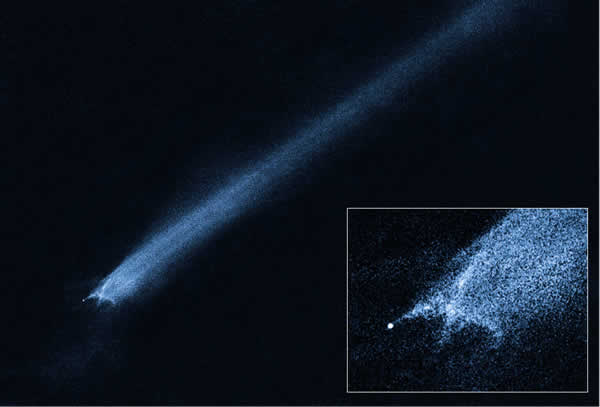Dying Space Rock: Asteroid-Comet Hybrid Discovered
NASA's Hubble Space Telescope has observed a mysterious X-shaped debris pattern and trailing streamers of dust in 2010 that suggested a head-on collision between two asteroids.
At first blush, the object founding soaring through the asteroid belt looked like a comet, most notably because of its long, well-formed tail. But a follow-up investigation with the Hubble Space Telescope revealed its true identity as an asteroid, albeit one of the most bizarre ever discovered.
Trailing the asteroid’s body is stream of particles and dust stretching more 1 million kilometers (621,371 miles) across the sky. That’s three times the distance of Earth to the moon.
It also has an odd, X-shaped debris field, which may be evidence that the object, known as Asteroid P/2010 A2, collided head-on with another asteroid in the not-too-distant past. Another theory is that A2 is breaking itself apart due to an unsustainable spin.
“It’s hard to pin it down,” astronomer Jayadev Rajagopal, with the National Optical Astronomy Observatory, told Discovery News.
“This one certainly looks like it’s a collision,” but there are many mechanisms that may explain it, he said.
Of the roughly 12 so-called “active asteroids” found so far, nothing rivals A2.
“We are watching the death of an asteroid,” Rajagopal said at the American Astronomical Society conference in Indianapolis this week. “This is the only one which is showing the event as it is happening.”
A2 is giving scientists a first-hand look at one way for water, volatiles and other materials to be delivered into the inner solar system.
“This seeds the very materials of life to the Earth,” Rajagopal said.
“We usually associate tails and coma and mass loss with comets. We think of them as dirty iceballs with mass kind of shedding off them. But there are a few asteroids which are starting to show us that asteroids have this activity too,” he said.
Follow-up observations are under way to measure how much material is in A2's tail, which presently is shaped like a tube. Eventually, the tail will widen and more closely resemble the dusty trails of comets that trigger meteor showers on Earth when the planet passes through the stream.
Discovered in January 2010, A2 has now completed one orbit around the sun under the watchful eyes of astronomers. How long it lasts will depend on the size of its particles and how fast they are moving.
“I expect it to hang around for quite a while,” Rajagopal said.
P/2010 A2 was discovered robotically by the Lincoln Near-Earth Asteroid Research project, a collaboration of the U.S. Air Force, NASA and the Massachusetts Institute of Technology. Later, astronomer David Jewitt, with the University of California at Los Angeles, used Hubble to get a closer look at the object and determined that its tail wasn’t smooth like a comet's.
A2’s tail has filaments with dust and gravel, some of which are pushed back by the pressure of sunlight, which leaves behind streaks.
“Embedded in the filaments are co-moving blobs of dust that likely originated from tiny unseen parent bodies,” Jewitt said after the Hubble observation.
Astronomer used a new wide-angle camera on the WIYN 3.5-meter telescope on Kitt Peak to get a sense of just how long A2’s tail is. Even though the camera can see a slice of sky about as wide as the full moon, A2’s tail extended beyond its view.
“What was astounding is that it actually was all the way out of the field of even our image and that was totally unexpected,” Rajagopal said.(Jun 4, 2013 07:00 AM ET // by Irene Klotz)












